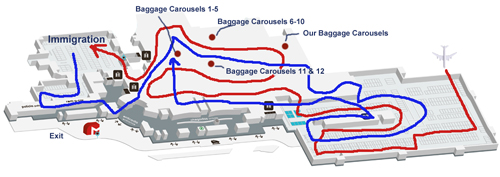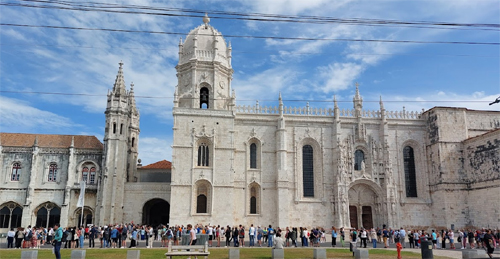-
Portugal – Part I
Tuesday, 16 May 2023: Getting There
Travel days are always fraught with angst, brought on by the certainty that somehow, somewhere, something is sure to go wrong. And it usually does. That’s why we like traveling with an organized tour, because no matter how badly the traveling goes, you can be sure that someone will greet you at the other end.
This time, however, it was the greeting at the other end that went wrong.
We made the train (no strikes), the plane took off on time (no drama over having failed to check-in on-line) and landed safely.
After disembarking, we were led on a merry quest from one end of the terminal to the other, and back again, searching for Immigration and our luggage.

Really, what could be simpler?
But with all that behind us, we wound our way through the labyrinthine shopping plaza that is Duty-Free until we were vomited out into the Arrivals Lounge where no one was waiting for us.
We walked from one end of the terminal to the other looking for someone, anyone, holding a New Market sign, but to no avail. After half an hour of fruitless searching, we ran into another member of our group who was just as lost as we were.
Leaving my wife and our fellow castaway to guard the baggage, I searched from the taxi ranks, to the car rental desks, to the bus garage, both inside and outside, buttonholing anyone with a clipboard, or standing in a cluster of four or more, hoping they might be from our group, but all I discovered was that, in Lisbon airport, a surprising number of people do not speak English.
Returning empty-handed, we decided our situation warranted a call to the emergency number, but after playing Option Roulette with a robot for about ten minutes, the robot hung up on me. I was attempting to reconnect when—45 minutes after we arrived—the tour manager showed up, without apology, and seemingly surprised that we had over-reacted.
It was not surprising, however, that we were the only three she was able to collect. After she took several trips around the terminal, we were driven to our destination where we later discovered that the others in our party had given up and had taken a taxi to the hotel.
…
The Pousada Palácio Queluz

The Pousada Palácio Queluz
It bares noting that our accommodations on this trip are part of the Pousadas de Portugal, a chain of luxury, traditional or historical hotels formerly run by the State, but which are now run by the Pestana Group. This particular hotel—the Pousada de Queluz—was once the Guardhouse for the Royal Palace, and it was stunning.
Happily, even with our airport delays, we still had time to settle into our room and go on a walkabout before dinner. I even had time to visit a nearby café and sample the local beer.
Being in this Pousada is like going back in time. Not far, like when you visit the Isle of Wight, just far enough to be comfortingly familiar. There is an actual key for our room, not a plastic card that opens the door, turns on the lights, and tells the front desk if you nick anything from the mini-bar. And they take cash here! And some places don’t even accept card payments. How quaint. The other astounding thing was, when the woman at the café (one of the places that does not take card payments) found out that I had no euros on me, she told me I could drink my beer, then go get the money. Try that at your local Starbucks.

Pousada de Queluz according to the brochure,
Pousada d. Mariai according to the room key.
It was not far outside of Lisbon, in a quieter, more leafy area.Strangely, the dining room was across the road, in a vast, lavish building that used to be the Royal Kitchen.
The meal was a very posh affair, with a set menu and attentive service; not at all like Nando’s or Applebee’s. The trouble with a set menu, however, is you take what they give you. Now, I don’t recall being asked if my wife was a vegetarian when I booked the holiday; had I been, I certainly would have noted it. But, alas, no such option had been offered, so my vegetarian wife was served pork loin with sautéed potatoes. I, therefore, had a double portion of pork loin while my wife enjoyed an additional helping of potatoes. And I have to tell you, they were, far and away, hands down, the best pork loins I have ever tasted: melt-in-the-mouth tender, succulent and flavourful. I enjoyed every bite.

Extremely POSH, but not much choice.
I’m not sure how my wife faired with her sautéed potatoes, however.
Strangely, the Tour Manager (let’s call her TM) did not sit with us. When she arrived at the dining room, they set up a special table for her, well apart from the tour group, where she ate alone. This curious behaviour continued throughout the tour.
With the meal over, we traversed the cobbles back to our hotel, where I endured the second-most uncomfortable night’s sleep in living memory. The height of luxury, it transpires, is a firm mattress and feather pillows, not taking into account that firm mattresses do not suit everyone—i.e., me—and many people are allergic to feathers—i.e., my wife. Additionally, they do not seem to comprehend that a bag of feathers, when pressure is applied, squashes flat, turning it into a pillow the size, thickness and consistency (as well as comfort) of a well-used welcome mat.
Rested and refreshed (not), we began our first full day of touring with the discovery that the pull-cord in the bathroom does not turn on the exhaust fan, but instead alerts the front desk of an emergency. Fortunately, a simple, but embarrassing, phone call set us straight. The second thing we learned was how to pour Portuguese coffee which, due to its strength, is half a cup of coffee topped up with milk.
We then set out for our tour of Lisbon.
Throughout this travelogue, I will, naturally, note the little niggles that went wrong, but that is for entertainment purposes (no one wants to hear, “everything went well, and we came home”), so allow me to state up front that it was an amazing holiday with many pleasant surprises, lovely weather, stunning scenery, superb accommodations, good food, great wine, and companionable company. Seriously, if you have not visited Portugal, you must go.

Nice church, and a very long queue.
At a brief stop in town, we saw a magnificent church with an impossibly long queue, then we went to the riverside to see an old tower that had once been in the middle of the river but was now on the bank. The brochure says, “Check out the street sellers,” but you don’t have to go looking for them, they swarm around you like mosquitoes, just as numerous, persistent, and welcome.

Mosquitoes swarming tourists as they step off a bus.
As we left the riverside, TM took a headcount, and we set off, with one person not on the bus. Fortunately, we saw her as we were pulling out and shouted for the bus driver to stop.
Allow me to preface this next bit by admitting that I do not speak a word of Portuguese. I am, however, not in charge of a tour group. TM’s tenuous grasp of the English language and her unique turns of phrase, coupled with my drowsiness and not-so-great hearing, made following her monologues challenging:
“You see in the hills de houses but cannot buy. No money. No money. Because 1755 earthquake, all destroyed, and they became lobsters and go to Brazil. And here, you see is where the land is finishing and the Atlantic Ocean, it is beginning. You must be attention. The bus stop here, and where you go from is how you return. One hour.”
We saw some other sites before being released, then my wife and I wandered around, had lunch at a nice sidewalk café, and went down to the waterfront through a magnificent gateway. The weather was gorgeous, and it was a nice, relaxing day.

Magnificent archway, with the sea in the background.
For dinner, we went to the café I had visited the previous afternoon for drinks and snacks.

Beer, €1.20 a bottle, Wine, €2.00 for a glass (large)
The next day, according to the Brochure, we would, “explore the elegant Atlantic resorts of Cascais and Estoril,” but all we did was drive through them. That, I suppose, could be considered an exploration and, at any rate, they did not look inviting.
We then drove to the Portuguese Land’s End, which was less tacky than the UK’s Land’s End, but ultimately offered the same thing: a look at the Atlantic Ocean.

Portuguese Land’s End. Not as tacky as the UK’s.

Next stop, America. “I can see my house from here.”
From there we went to Sintra, a lovely UNESCO-listed town that was so chuck-a-block with tourists that we could hardly move (I realize, of course, that we were part of the problem). Fortunately, Sintra is built on steep hills, and tourists are lazy, so after climbing for a bit, we found a restaurant that was nearly deserted where we had a lovely cheese and meat platter lunch in relaxed surroundings.

Sintra, with tourists

Sintra, without tourists (they’re all at the bottom of the hill).

Sintra, the view.
Back at the hotel for our final evening, we returned to our favourite café for a drink, said a quiet good-bye to our lovely hotel, and retired to our room.
Up Next: The Pousada de Viseu